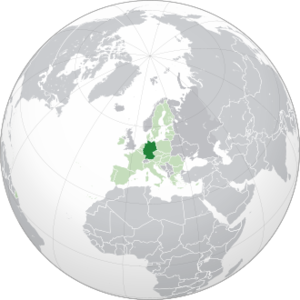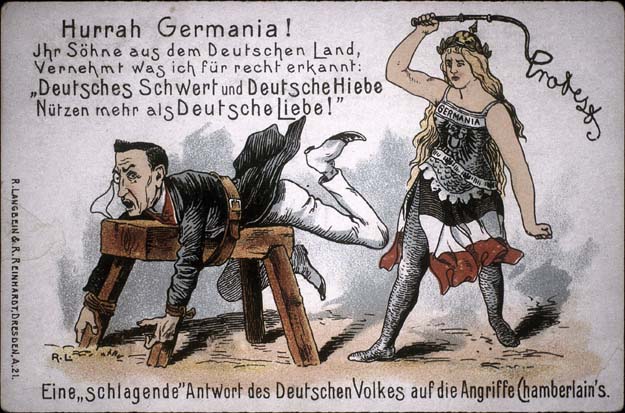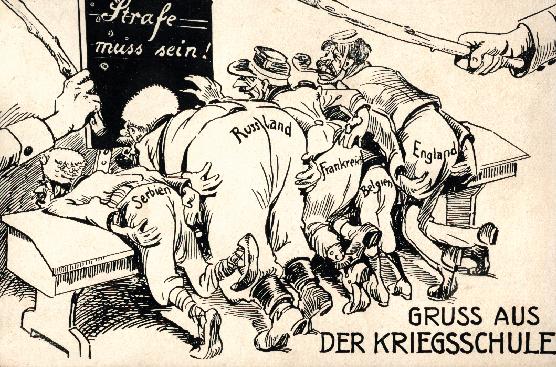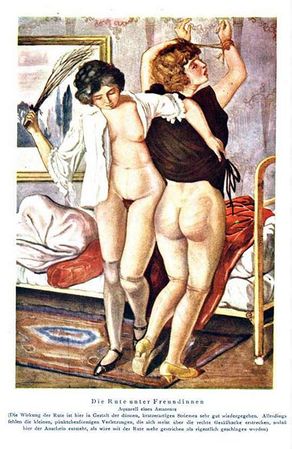Germany
| Germany |
|
|
Source information is available at [ Sources ] |

Germany is a country in Europe with a population of about 82 million. Its official language is German.
This article is intended to give a general overview of the BDSM lifestyle in Germany. A potentially more comprehensive and up-to-date view, in the German language, is available from SMiki.
History
It should be noted that although the term "BDSM" is known and used in Germany, it is not as widespread as simply combining everything that the English-speaking countries group under that label, under "Sadomasochism" (or rather, Sadomasochismus). This article reflects this usage.
In Germany, in particular, the involvement of medicine in the conception of Sadomasochism is crucial. Leopold von Sacher-Masoch was born in nearby Austria-Hungary and died in Germany. Richard Freiherr von Krafft-Ebing (who formally defined Sadism and Masochism for the first time as illness) worked in Germany, and the physician Andreas Spengler, who replaced the picture of the lonely patient by that of the socially inconspicuous member of a subculture, is also German. Only the Marquis de Sade (a Frenchman) seems missing.
Legal status
In both Germany and Austria, SM is treated widely and uniformly as a bodily injury with consent, and it thus has a status comparable to medical surgery and martial arts. Germany differs from Austria in that SM does not violate good manners. Abuses of state power against Sadomasochists because of their sexual preferences are largely unknown in Germany.
Legal certainty
The German judicial system values stability of justice highly. Existing laws and judgments are rarely contested in court; instead, new rules are established. Sadomasochists operate in a clearly defined national uniform legal environment.
Privacy
Article 1 of the Basic Law—protecting the dignity of the people—derives protection of privacy, particularly in relation to the media. The privacy of individuals is protected even in contemporary history.
Censorship
The censorship situation in Germany is relatively unfavorable for Sadomasochists.
Political censorship
Article 5 of the Basic Law prohibits censorship, although it is permitted by other laws. The protection of minors and the "right of personal honor" is limited. According to the Federal Constitutional Court, Article 5 applies only to prior censorship. The European Convention for the Protection of Human Rights indicates that "protection of morals" is a permissible reason for censorship.
In recent decades, the right to liberty of opinion has been increasingly limited in Germany.
The two main reasons have been:
- Protection of children and young people
- There are strict guidelines on the protection of minors, which also affects adults, making some media virtually impossible.
- Protection of human dignity
- Although there are no clear criteria exactly when a violation of human dignity occurs, this justification makes major areas of sexual depictions widely prohibited (e.g. pornographic depictions of sexual acts with animals). Partially for this reason also, the possession of materials may be forbidden.
Economic censorship
An indexing by the BPJM (German censor body?) with the pertinent advertising prohibition often destroys the value of a medium from the publisher's perspective and is, in most cases, the death knell for the medium. In many cases, an indexing means that the work remains unpublished. The small market of little more than 100 million German speakers worldwide gives little profit clearance for edge publications despite the application of fixed book prices.
Other influences
Religious and arch-conservative groups with a 'sadophobic' agenda in Germany have little influence.
A vociferous campaign by a group of radical feminists led by Alice Schwarzer in the 80s for a prohibition on erotic media had sadomasochism pictured as an enemy, but this died out in the 90's with almost no effect.
A more subtle form of censorship is partly due to the translation or synchronization of foreign materials.
Subculture
Germany has a pronounced organized subculture, including munches, clubs and associations.
There is a Federal union, the Bundesvereinigung Sadomasochismus (BVSM), founded on 31 May 2003 in Cologne, uniting diverse groups and individuals in the SM subculture.
The favorable legal situation gives Sadomasochists in Germany little reason for their cause to go public. The number of people who are open about their inclinations regarding Sadomasochism, in comparison to countries like the USA, is small.
Between homosexuals and heterosexuals in the subculture, only loose connections exist. In some parts of the non-commercial subculture, reservations exist against the commercial scene.
Size of the subculture
Exact numbers on the size of the subculture are not available. Some data from July 2003 indicate that there were at least 84 groups, 39 mailing lists, Web groups or IRC forums, and 10 other institutions.
History
During the Third Reich, sadomasochism was considered as poorly as homosexuality. From this period also comes the addition of body injury paragraphs in the Criminal Code, SM to be a criminal offense. This (still existent) Addition is not applied to today's courts.
Even in the GDR, Sadomasochists had to count on Repression.
The first well-known SM meeting in the FRG was a 1964 Stammtisch for gay Sadomasochists in Cologne.
Spanking in Germany
In the 20th century, school corporal punishment fell out of fashion and was gradually banned in many countries, a trend that continues until the present day.
As of May 2008, Germany prohibits corporal punishment in schools. Corporal punishment in parenting and education had a long tradition in Germany until it became frowned upon and eventually illegal in the 20th century. Spanking implements that were traditionally popular in Germany included the birch (up to the 19th century), the cane (19th to mid-20th century), sticks, switches, belts, straps, and household items such as wooden spoons or carpet beaters.
School corporal punishment included not only spankings given with the birch or cane, but also other forms of corporal punishment such as face slapping (Ohrfeigen) or striking the student's hands with a cane, stick or ruler (Tatzen). See Johann Häberle for a German school teacher's account of corporal punishment in 1750.
A shame-based method of punishment used in German schools up to the 19th century was the donkey cap (a cap with "donkey ears," using the animal as a symbol of stupidity) and riding a wooden donkey.
Corporal punishment in German schools was abolished in 1949 (East Germany) and 1973 (West Germany). In 1998, corporal punishment, as well as any other kind of "degrading" punishment in parenting, was outlawed in Germany.
German spanking art
There is historic German spanking art from the Middle Ages and Renaissance up to modernity. A well-known 19th century German poet and cartoonist, Wilhelm Busch, made many references to spanking in his humorous verse and cartoon illustrations. A 19th century German spanking author is Wilhelm Reinhard who wrote Nell in Bridewell.
German spanking artists from the early 20th century include Helga Bode, Richard Hegemann, Paul Klamm (C. Soulier), Otto Schoff and possibly Hata Deli, Alphonse Friaux and/or R. Planitz. There also is (or was) Max Raute. Contemporary German spanking artists include Alina, CM Zero, Darius and DT.
Ernst Schertel was an important German collector and (semi-)scientific analyst of spanking art (Der Flagellantismus als literarisches Motiv).
German spanking forums and clubs
There are a number of spanking forums, most of which also organize munches, parties, workshops or other meetings in real life. These include Spankingfreunde, Spanking-Liebe, Spanking-Oase, Spanking Silo, and Spankodrom.
Gallery
Die Rute unter Freundinnen, watercolor painting by Helga Bode.
Spanking videos
A selection of German-produced videos and other titles featuring German-related themes and/or actors.
- Best of the Brits, Vol., 23 (Strictly English), The German Au-Pair section, photos
- The Big Mistake: The Interrogation of Justine (PainGate), photos
- Border Guard Blisterings (Raven Hill Studios), East Germany setting (Xhampster video, SpankBang video)
- Christmas Bonus: Krampus Spanking (Clare Spanks Men), based on German folklore, photos
- Demonstration of caning in a German school (video)
- East German Institute (CanedSchoolGirls.com), Miss Thompson, Penelope Parker, German Tom, Grace, photos
- East German Inquisitor (PainGate), photos
- Firm Hand On Lili's Butt (Lovely Fetish, Germany), Aron, Lily, video
- Fraulein Ritter (Nu-West/Leda Productions, 1984), German cast members
- From Germany to Real Discipline 1 (Dallas Spanks Hard), German amateur Chrissie, photos
- From Germany 2, aka German Girl 2 Severe (Dallas Spanks Hard), Chrissie, photos
- The German Au Pair (Strictly English), nanny, https://onlyspanking.video/43803-the-german-au-pair-strictlyenglishonline-sd-mp4.html photos]
- German BDSM & Spanking with Heidi
- German breast torment video
- German Dance School Punishment (Cruel Alice), photos
- German Lessons (CanedSchoolGirls.com), Miss Thompson, Penelope Parker, German Tom (photos)
- Herr Schubert, Girls Headmaster (Nu-West/Leda Productions, 1984), German dialog and cast (photos, video, near-complete video)
- I've Been a Bad Girl So Tied Me Up and Beat My Ass to Teach Me a Lesson (Hunters Lair Bondage), with German masochist Emily Addams, ball gag, spanking bench (photos)
- Krampus Christmas Spanking (Girl Spanks Girl), fantasy, photos
- Krampus Night (Cruel Alice, 2023), Lavinia, folklore fantasy, photos
- Krampus Spanks Naughty Girl (Spanking Veronica Works), Veronica Ricci, based on German folklore, photos
- Lady Marlon and the Prisoner (PainGate), East German prison, photos
- Masochistic Rope Faerie (Lovely Fetish), video
- Mildred Scott - Company Disciplinarian (Nu-West/Leda Productions, 1984), German actress Inga (complete video at SpankBang)
- Mildred Scott - Housemother (Nu-West/Leda Productions, 1984), Inga, Hilda, Anne, video, video 2
- More of Margaret Thatcher, Marriage Counselor (Nu-West/Leda Productions, 1984), German actors Inga/Helga, Sonya, Hans (photos, video)
- The Pain Forest, aka Der Schmerzwald (Schwarze Flamme), video
- The Punished Thief (Lovely Fetish), video
- Russian Spy Investigation 1-2 (PainGate), East German setting, photos, part 2 photos
- Slave's Free Will (Lovely Fetish), Aron, Lili, video
- Slave's Punishment (Lovely Fetish), Aron, Lili, video
- The Spanish Horse I (Sir X, c. 2008), Spanish horse, clothes-pins, blindfold (video)
- The Spanish Horse II (Sir X), clothes-pins, wax play, ball gag (video)
- The Spanish Horse V (Sir X, 2009), clothes-pins, video
- The Spanish Horse VIII (Sir X, 2009), clothes-pins, nipple clamps (video)
- Spanked Wives (Nu-West/Leda Productions, 1984), German actresses Jennifer & Ingrid, video
- Spanking the School-Girl and Her Director (c. 1990), video
Nazisploitation spanking and BDSM videos:
- A17 - A Boot Camp Tragedy (Whipped Women), pillory, photos, video
- Behind the Iron Curtain (Whipped Women, 2021)
- Boot Camp: Stable Work (Whipped Women), video
- Dr. Mengele (Mood Pictures, c. 2007), discontinued title (photos, video)
- German Sadism (Whipped Women)
- Gestapo (Mood Pictures, 2005), discontinued, photos, SpankBang video
- Gestapo 2 (Mood Pictures, 2006), discontinued, photos, video
- Gretchen's Punishment (Whipped Women, 2017)
- The Spy (Pain4fem, 2007), Niki Flynn spanked, flogged, etc. (photos, 36 min. video).
- Wonder Christina vs. The Fraulein (Hypnotics World), Christina Carter, camp WWII story
Prostitution in Germany
- Prostitution in Germany ↗ on Wikipedia
See also
External links
- The BVSM (German language), a German focal point
- Demonstration of caning in a German school (M/B photo)
- CIA Factbook link for Germany
- Images from Germany on Bing.com
- More information is available at [ Wikipedia:Germany ]
Chat rooms • What links here • Copyright info • Contact information • Category:Root




